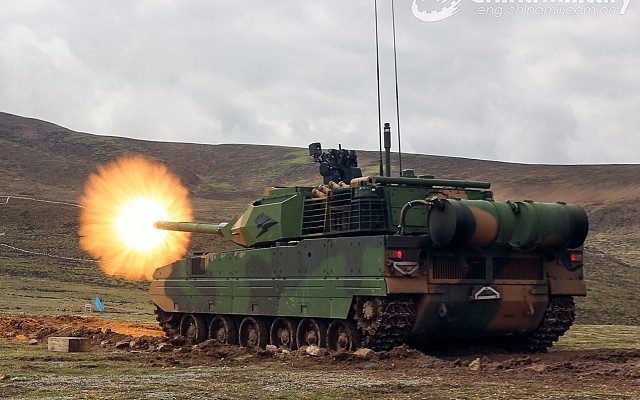ZTQ15
Type 15 light tank
Overview

ZTQ15
A ZTQ15 light tank in desert camouflage seen on parade.
Source: Unknown author -
© Copyright lies with original owner
500+ by 2022
15式轻型坦克
Chinese for "type 15 light tank"
黑豹 / Black Panther
VT-5 (export model)
Bangladesh
Description
Introduction
The ZTQ15 is a modern era light tank of Chinese origin. It was developed to replace older light tanks for use in areas of China in which heavier vehicles impractical. The ZTQ15 is a quantum leap forwards in performance of older Chinese light tanks, which were behind the curve their entire service life. Various exports configurations have been shown under the name VT-5.
Design
The ZTQ15 follows the general configuration of the ZTZ96 main battle tank. It has a conventional layout with the driver at the front, turret center and engine at the rear. Compared to the earlier Type 62 the ZTQ15 is a vast improvement in firepower, mobility, protection and digital capabilities. Various prototypes with different engines, drivetrain and armor packages were tested. Early prototypes reportedly had hydropneumatic suspension, which changed to a more common torsion bar suspension for the production vehicle. Various prototypes of the VT5 export variant of the ZTQ15 likely reflect some of these prototypes, having
Firepower
A 105mm rifled gun is the main armament of the ZTQ15. This is said to be an improved version over the ZPL94 that has been used in various light tanks, such as the ZTD05 amphibious light tank and ZTL11 wheeled assault gun. The new gun is to be used with an improved APFSDS round said to penetrate 500mm RHA. It can also fire other types of ammunition and can launch anti-tank guided missiles with tandem HEAT warhead and 5 km range from the barrel. The gun is fully stabilized and has a modern fire control computer with laser range finder. The gun is fed from an automatic loader with magazine in the rear bustle of the turret. Coaxial armament is a 7.62mm machine gun. A 12.7mm QJC88 heavy machine gun is mounted on the roof in a remotely operated mount.
Protection
ZTQ15 has a modular armor package. The hull and turret are made of welded steel and protect from small arms fire and shell splinters all around. Over the frontal arc the baseline armor likely protects against heavy machine gun fire and smaller autocannon shells. In Chinese service the ZTQ15 is mostly seen with a standard ERA package on the hull front and turret front and sides. Applique armor can be added to the hull sides and a heavier ERA package can added to the hull and turret front. Stowage baskets on the turret double as slat armor against HEAT warheads. There are smoke grenade launchers that can be fired manually or by the laser warning system.
Mobility
With a weight in the mid-30 tons tons the ZTQ15 isn't very light, but likely suits the desert, high altitude plateaus and swamp/jungle terrain it is intended to operate. The 1.000 hp engine provides a good power to weight ratio. The autonomous range is higher than most main battle tanks. With a logistics footprint that is likely about half of a main battle tank. Maximum speed is 70 km/h on roads. The two-stage turbocharger reportedly helps functioning at high altitudes with lower oxygen level, allowing to still reach 60 km/h at high altitude.
Users
The ZTQ15 is used in significant numbers by China. It is mainly used by the PLA, but small numbers are reportedly in service with the marine corps and airborne units. It officially entered service in 2018, although selected and certified in 2015. ZTQ15 is available for export sales as the VT-5. The export configurations shown differ in various areas such as armor layout and hull design. The first known export customer is Bangladesh.
Details
Media
Armament

105mm rifled main gun
The ZTQ15 is armed with a further development of the ZPL94. The Royal Ordnance L7 has seen many design iterations in Chinese service.

7.62mm Type 86
A 7.62mm Type 86 coaxial machine gun is fitted. This design is derived from the Soviet PKT.

12.7mm QJC88
The 12.7mm QJC88 heavy machine gun is fitted in a remote weapon station. This can be fired from under armor protection, but in exercises is mostly seen controlled manually by the commander.
Related articles

Type 62
The ZTQ15 was developed to replace various combat vehicles in Chinese service, but most of all the Type 62 light tank.









